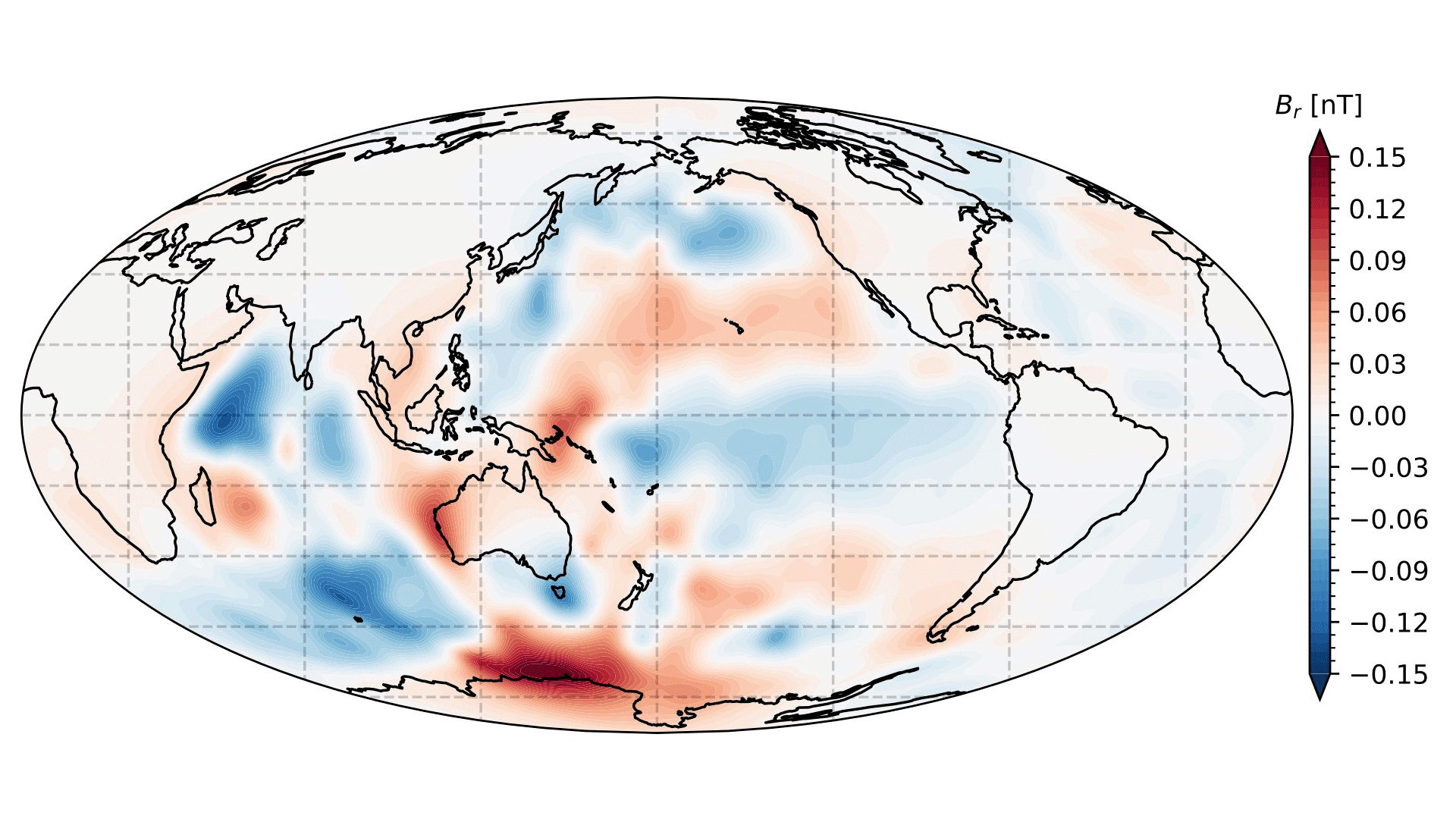Swarm for Ocean Dynamics
Exploring the potential of satellite magnetic field observations to provide information on dynamics, heat content and salinity of the oceans.
About
It is well established that the ocean generates a time-varying magnetic field that depends on its motions and electrical conductivity structure. With ten years of high quality observations now available from the Swarm satellite trio, and with recent advances in geomagnetic field modelling and data processing strategies, there are now new possibilities for extracting this signal of interest.
The ESA funded Swarm for Ocean dynamics project aims to retrieve the ocean-induced magnetic field signal and to interpret it based on advanced numerical simulation using the latest oceanographic information. It involves (i) a dedicated scheme for processing Swarm satellite data including corrections for known signals of magnetospheric and ionospheric origin, (ii) high resolution global modelling of the time-dependent internal field at Earth’s surface (iii) spatio-temporal filtering to isolate the time-varying ocean-induced magnetic signal, and (iv) analysis of high resolution numerical simulations based on 4D oceanic flows and conductivities.

Simulations
We are carrying out a suite of simulations of the ocean-induced magnetic field in order to investigate the magnetic signal expected from the general circulation of the ocean and the sensitivity of this signal to oceanographic parameters. We take as input estimates of 3D velocity fields as well and temperatures and salinities, from which we compute electrical conductivities via an equation of state, from various versions of the ECCO and CMEMS ocean state models.
We use realistic models of the electrical conductivity of ocean sediments and are testing the impact of 1D and 3D mantle conductivity models on the results. In addition we are testing different models for the underlying core magnetic field (in particular we consider either IGRF or the CHAOS field model). The simulations are carried out on a high performance computer cluster using the elmgTD_mpi code (Velímský et al. 2019) which solves the 3D magnetic induction equation in the time-domain using a parallelized finite-element/spherical harmonic discretization that includes self-induction and galvanic coupling effects.

Simulated radial magnetic field at the Earth's surface on 21st March 2013, based on the CMEMS mean oceanographic model. Scale +/- 4 nT.
Satellite data

RMS values between 2013 and 2023 of the processed Swarm-A magnetic field data at satellite altitude, after removing internal and external field corrections, computed on an equal area grid.
We have developed a pre-processing scheme for magnetic field data collected by ESA's Swarm satellite trio, designed to correct as best as possible for known non-oceanic sources of the geomagnetic field. In particular we have made an effort to correct for magnetospheric and ionospheric fields using dedicated models of these sources, carrying out a daily scaling of the predictions and treating the ionospheric field in the polar and non-polar regions separately.
The image to the left shows the remaining RMS residual radial magnetic field at satellite altitude, taken over 2013 to 2023, as a function of geographic location. Largest disturbances remain in polar regions where it is difficult to correct for the highly dynamic ionospheric currents. At mid and low latitudes the corrections perform much better, giving a dataset suitable for studying the ocean magnetic field.
Extracting the ocean's magnetic signal
Based on pre-processed Swarm satellite data (with corrections applied for magnetospheric, ionospheric fields as described above) we are constructing high resolution time-dependent internal field models. These are parameterized so they are able to capture ocean-induced magnetic field variations from interannual down to three month periods for spherical harmonic degrees up to thirty. Due to the presence of imperfectly corrected external and related induced signals, further post-processing is however required in order to extract the ocean-induced magnetic field signal of interest.
We are working on specially designed filters to extract as best as possible the ocean signal and comparing the results to the signal expected based on simulations in an effort to test the feasibility of extracting the ocean-induced signal. As a proof-of-concept we are concentrating on the signal in regions where a strong signal is expected, for example in the Indian Ocean (see image to the right).

Estimated radial magnetic field in the Indian Ocean region on 19th Jan 2019, filtered to retain only spherical harmonic degrees 19 to 30, orders greater than 5, in the annual period band.
Project partners
DTU Space
Charles University of Prague
Project outputs
Forward simulation datasets (from CUP):
Processed Swarm satellite datasets (from DTU):
-
C.C. Finlay, J. Velímský, C. Kloss, and R.M. Blangsbøll (2024) Satellite monitoring of long period ocean-induced magnetic field variations, Phil. Trans. R. Soc. A.38220240077 http://doi.org/10.1098/rsta.2024.0077
- Poster presented at Swarm 10year Anniversary meeting, Copenhagen, Denmark, April 2024
- Poster presented at Ocean Salinity Conference 2024, ESA ESTEC, Netherlands, May 2024
- Poster presented at IAGA EM Induction Workshop, Beppu, Japan, September 2024
- Talk presented at Swarm Data Quality Workshop, Bucharest, Romania, October 2024




